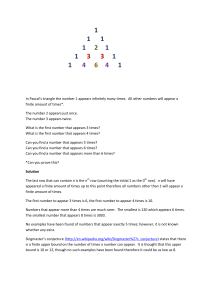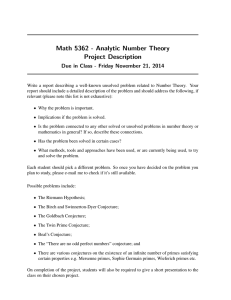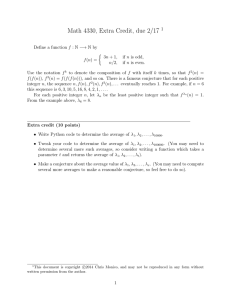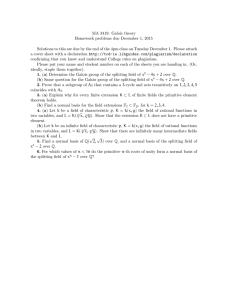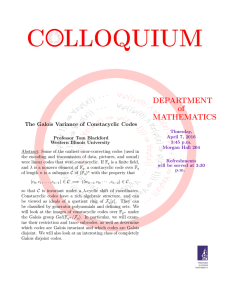Galois groups of tamely ramified p-extensions Journal de Th´ eorie des Nombres
advertisement
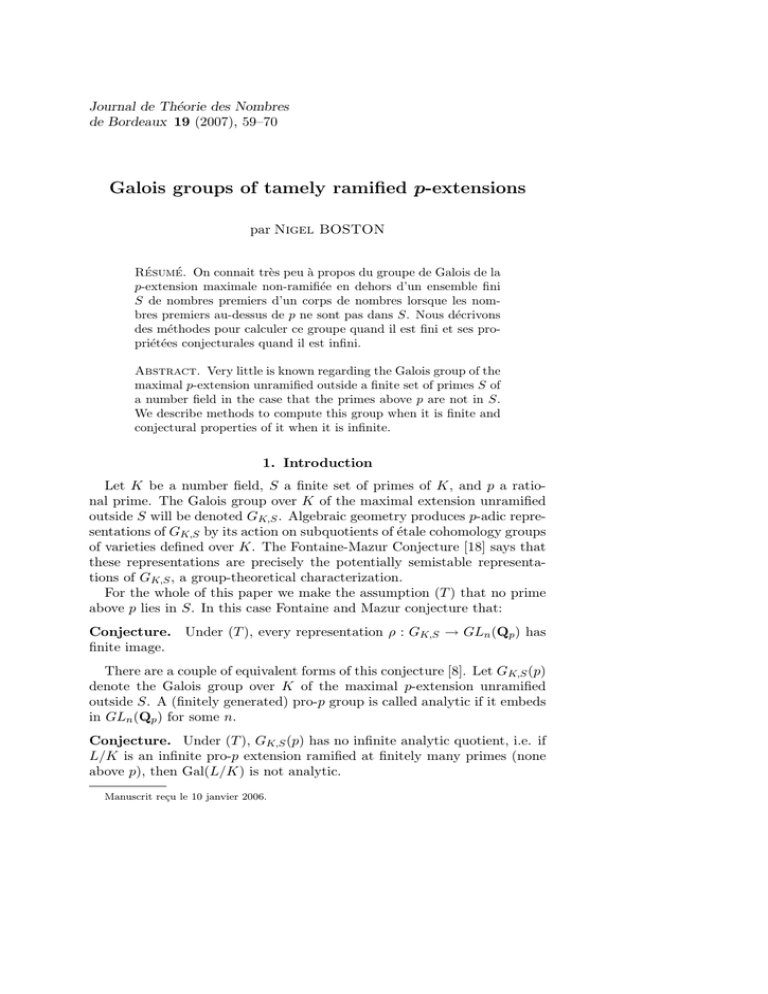
Journal de Théorie des Nombres
de Bordeaux 19 (2007), 59–70
Galois groups of tamely ramified p-extensions
par Nigel BOSTON
Résumé. On connait très peu à propos du groupe de Galois de la
p-extension maximale non-ramifiée en dehors d’un ensemble fini
S de nombres premiers d’un corps de nombres lorsque les nombres premiers au-dessus de p ne sont pas dans S. Nous décrivons
des méthodes pour calculer ce groupe quand il est fini et ses propriétées conjecturales quand il est infini.
Abstract. Very little is known regarding the Galois group of the
maximal p-extension unramified outside a finite set of primes S of
a number field in the case that the primes above p are not in S.
We describe methods to compute this group when it is finite and
conjectural properties of it when it is infinite.
1. Introduction
Let K be a number field, S a finite set of primes of K, and p a rational prime. The Galois group over K of the maximal extension unramified
outside S will be denoted GK,S . Algebraic geometry produces p-adic representations of GK,S by its action on subquotients of étale cohomology groups
of varieties defined over K. The Fontaine-Mazur Conjecture [18] says that
these representations are precisely the potentially semistable representations of GK,S , a group-theoretical characterization.
For the whole of this paper we make the assumption (T ) that no prime
above p lies in S. In this case Fontaine and Mazur conjecture that:
Conjecture. Under (T ), every representation ρ : GK,S → GLn (Qp ) has
finite image.
There are a couple of equivalent forms of this conjecture [8]. Let GK,S (p)
denote the Galois group over K of the maximal p-extension unramified
outside S. A (finitely generated) pro-p group is called analytic if it embeds
in GLn (Qp ) for some n.
Conjecture. Under (T ), GK,S (p) has no infinite analytic quotient, i.e. if
L/K is an infinite pro-p extension ramified at finitely many primes (none
above p), then Gal(L/K) is not analytic.
Manuscrit reçu le 10 janvier 2006.
60
Nigel Boston
Call a pro-p group just-infinite if its only infinite quotient is itself.
Every infinite, finitely generated pro-p group has a just-infinite quotient
and the tame Fontaine-Mazur conjecture reduces to a statement about
these quotients.
Conjecture. Under (T ), no just-infinite quotient of GK,S (p) is analytic.
This begs the question of what these just-infinite quotients actually are
then.
In this paper, a natural conjecture is made regarding the pro-p groups
GK,S (p) under assumption (T ). This is analogous to the virtual positive
Betti number conjecture on fundamental groups of certain 3-manifolds.
This conjecture leads to interesting refinements of the above FontaineMazur Conjecture and suggests that there should exist a theory of ‘arboreal’
Galois representations in parallel to the established theory of p-adic Galois
representations. This latter theory is probably of no help in investigating
GK,S (p) under assumption (T ), as indeed the Fontaine-Mazur conjecture
predicts. The new theory of arboreal Galois representations gives glimpses
into a rich new field at an early stage of development.
2. VGS Conjecture
For many years it was not known whether under (T ) infinite GK,S (p)
even existed. Finally, this was resolved by Golod and Shafarevich [20].
The generator rank and relation rank of a pro-p group G will be denoted
by d(G) and r(G) respectively.
Definition. A pro-p group G is called Golod-Shafarevich if d(G) and r(G)
are finite and satisfy r(G) ≤ d(G)2 /4.
The following two theorems imply for instance that under (T ), GQ,S (p)
is infinite if S is a finite set of rational primes with at least 4 elements.
Theorem 2.1. (1) Every Golod-Shafarevich pro-p group is infinite [20].
(2) d(GQ,S (p)) = r(GQ,S (p)) = |S| [33].
If |S| = 1, then GQ,S (p) has 1 generator and 1 relator, so is finite, cyclic.
If |S| is 2 or 3, then there are examples known both of finite and infinite
GQ,S (p). An illustrative example is the following:
Example. [11] Suppose p = 2 and
S = {q, r,s} where q, r, s ≡ 3 (mod 4)
and cannot be ordered so that qr = rs = qs , e.g. S = {3, 19, 43}. Then
GQ,S (p) has a subgroup H of index 2 whose fixed field is imaginary. An
extension of Theorem 2.1(2) implies that r(H) = d(H). By class field
theory, H ab is isomorphic to the 2-Sylow subgroup of a ray class group,
calculated to be (Z/2)4 , denoted [2, 2, 2, 2] for simplicity. Thus, d(H) =
Tame Galois groups
61
r(H) = 4 and since H is Golod-Shafarevich, it is infinite, as must GQ,S (p)
be.
My main claim is that this approach to showing infiniteness should be
generally applicable. More precisely, in analogy with Lubotzky’s conjecture
on 3-manifold groups [29], I conjecture:
Virtually Golod-Shafarevich (VGS) Conjecture. If L/K is an infinite pro-p extension ramified at finitely many primes (none above p),
then Gal(L/K) has an open (i.e. finite-index) subgroup that is GolodShafarevich.
We begin by obtaining some refinements of the Fontaine-Mazur Conjecture as consequences. These depend on a famous conjecture of Zelmanov’s
that is close to being proven (and therefore denoted ). Many cases have
been established by Zubkov [37], Barnea-Larsen [3], and Zelmanov himself.
Conjecture . Nonabelian free pro-p groups are not linear.
Here, linear means over any p-adic ring, including e.g. Fp ((t)). Conjecture is related to our work via a theorem of Wilson and Zelmanov
[36].
Theorem 2.2. Every Golod-Shafarevich pro-p group contains a nonabelian
free pro-p group.
This now gives an explanation for the Fontaine-Mazur Conjecture under
(T ).
Theorem 2.3. The VGS Conjecture together with implies the FontaineMazur Conjecture under (T ).
This follows since Gal(L/K) cannot be both virtually-Golod-Shafarevich
and analytic. Indeed, it implies my extension of the Fontaine-Mazur conjecture that suggests that under (T ) every representation ρ : GK,S → GLn (R),
where R is any p-adic ring, should have finite image. In fact, we get much
more by using part of the (incomplete) classification of just-infinite pro-p
groups.
Theorem 2.4. (Grigorchuk [22]) A just-infinite pro-p group either
(a) has a subgroup of finite index isomorphic to H × ... × H with H
hereditarily just-infinite
or
(b) is branch.
Hereditarily just-infinite pro-p groups are ones where every finite-index
subgroup is also just-infinite. Since Golod-Shafarevich groups are never
just-infinite (except for Zp , which cannot arise here), we deduce the following, which answers the question posed towards the end of the Introduction.
62
Nigel Boston
Theorem 2.5. The VGS Conjecture together with implies that under (T )
the just-infinite quotients of GK,S (p) are branch groups.
A branch pro-p group is a certain kind of subgroup of the automorphism
group of a locally finite, rooted tree, and so this implies that there exist
actions with infinite image of GK,S (p) on such trees. In fact these actions
should be large in another sense.
Definition. [4] Let T be a locally finite, rooted tree, and Tn denote the
(finite) subtree of all vertices of distance at most n from the root. Let
G be a (closed) subgroup of Aut(T ) and Gn its image in Aut(Tn ). The
Hausdorff dimension of G in Aut(T ) is defined to be lim inf, as n → ∞, of
log(|Gn |)/ log(|Aut(Tn )|).
I conjectured that the branch groups are precisely those which embed
with nonzero Hausdorff dimension. Abért and Virág [1] produced several
interesting results concerning this conjecture. In fact:
Definition. Let T be a locally finite, rooted tree. A subgroup G of Aut(T )
is called spherically transitive if it acts transitively on the vertices at distance n from the root, for every n. The rigid stabilizer of vertex v is the
subgroup of G of elements acting trivially on the complement of the subtree
with root v. Then G is called branch if for every n the subgroup generated
by the rigid stabilizers of vertices of level n has finite index in G.
Finally, note that VGS Conjecture is analogous to the Virtual Positive Betti Number Conjecture, which states that the fundamental group
of certain 3-manifolds should have a subgroup of finite index with infinite
abelianization. This leads to the following definition.
Definition. A pro-p group satisfies FAb if every open subgroup of it has
finite abelianization.
Unlike the 3-manifold groups, our pro-p Galois groups satisfy FAb, since
class field theory identifies abelianizations with Sylow p-subgroups of ray
class groups and under (T ) those are finite. The VGS Conjecture and
Virtual Positive Betti Number Conjecture do however both indicate that
fundamental groups (pro-p or otherwise) are in some sense large.
3. Explicit finite Galois groups
We are curious about the structure of GK,S (p). There are various ways
to compute explicit presentations. One method, due to Leedham-Green
and me [11], is to find GK,S (p) in O’Brien trees [31]. We define the pcentral series of a finite p-group G by setting P0 (G) = G and Pc (G) =
[Pc−1 (G), G]Pc−1 (G)p (c = 1, 2, ...). The smallest c such that Pc (G) = 1
is the p-class of G. We say that G is a descendant of H if G/Pc (G) ∼
=H
Tame Galois groups
63
for some c. Thus the d-generated finite p-groups are the descendants of
Cpd . Organizing these descendants into a tree, the ends of the tree are the
d-generated pro-p groups.
O’Brien [31] makes it computationally efficient to search in these trees for
GK,S (p). Number-theoretical information such as the abelianizations of low
index subgroups (computed as ray class groups by class field theory), the
form of the relations (in the simplest cases all relations come from local tame
relations which say that a generator is conjugate to a certain power of itself),
and constraints on the number of relations coming from Galois cohomology
[26] is used to prune the tree. In [11] and [17], this was used to show in
some cases that GK,S (p) is one of a short list of groups. For example,
GQ,{5,19} (2) is isomorphic to either < x, y|x2 , yxyxy 3 xy −2 xy −2 xy −5 x > or
to < x, y|x2 , yxy 2 xy 2 xyxy 3 xy −5 x >, both of order 219 and 2-class 11.
4. Explicit infinite Galois groups
For infinite GK,S (p), this search fails, but we can impose a new condition
using the fact that GK,S (p) satisfies FAb. For K = Q all the relations are
tame and we define NT-groups as follows [9].
An [r1 , ..., rn ] NT-group is a pro-p group with presentation of the form
(∗) G =< x1 , ..., xn |xai i = xri i +1 for i = 1, ..., n >
where the ai are elements of the free pro-p group F on generators x1 , ..., xn ,
such that G satisfies FAb. The following theorem (of Shafarevich) captures
the fact that all the relations of GQ,S (p) come from local Galois groups.
Theorem 4.1. If S = {q1 , ..., qn }, then setting ri to be the highest power
of p dividing qi − 1, GQ,S (p) is an [r1 , ..., rn ] NT-group.
In [9], using Magma [7] it appeared that all [4,4] NT-groups have presentation < x, y|xa = x5 , y 4 = 1 > with a ∈ F , a particular subset of the
free pro-2 group on x, y. The shortest element of F is y 2 xyxy. Moreover,
the sequence log2 (|G/Pn (G)|) is always the same, namely
(†) : 2, 5, 8, 11, 14, 16, 20, 24, 30, 36, 44, 52, 64, 76, 93, 110, 135, 160, 196,
232, 286, 340, 419, 498, 617, 736, 913, 1090, 1357, 1634, ...
Putting sequence ∆n := log2 |Pn (G)/Pn+1 (G)| into Sloane’s On-Line Encyclopedia of Integer Sequences http://www.research.att.com/∼ njas/
sequences/Seis.html yields A001461, arising
in knotP
theory and quantum
P
field theory [13]. If so, ∆2n−2 = ∆2n−1 = nm=1 (1/m) d|m µ(m/d)(Fd−1 +
Fd+1 ), where µ is the usual Möbius function and Fn the nth Fibonacci number (so in fact Fd−1 + Fd+1 is the dth Lucas number).
Letting L(G) = ⊕Pn (G)/Pn+1 (G), the Fp -Lie algebra of G, it appears
further that all the [4, 4] NT-groups possess the same Fp - Lie algebra. There
are algebras arising in other areas of mathematics whose graded pieces
64
Nigel Boston
have the same dimensions, namely (i) the free Lie algebra generated by
one generator in degree 1 and one in degree 2 (arising in work on multizeta values and quantum field theory [13]) and (ii) Cameron’s permutation
group algebra [19] of C2 o A, where A is the group of all order-preserving
permutations of the rationals.
The VGS Conjecture now presents a method (map) for finding numbertheoretical cases to which the above applies. The abstract NT-groups above
each have a normal subgroup H of index 4 with d(H) = r(H) = 4 (and so
H is Golod-Shafarevich). To show that a particular GQ,∅ (2) is infinite, we
simply use this as a map to locate the corresponding number field (in this
case the quartic subfield of Q(ζq )) to which to apply the Golod-Shafarevich
criterion using Galois cohomology. It turns out then that if S = {q, r}
where q, r ≡ 5 (mod 8) are primes such that one is a 4th power modulo the
other but not vice versa, then GQ,S (2) is an infinite NT-group and so should
have the above form of presentation. This suggests the following amazing
possibility, which has been checked as far as computationally feasible.
Conjecture. Let S = {q, r} where q, r ≡ 5 (mod 8) are primes such that
one is a 4th power modulo the other but not vice versa. Then the pro-2
group GQ,S (2) is isomorphic to < x, y|xa = x5 , y 4 = 1 > where a ∈ F and
log2 (|G/Pn (G)|) is given by the sequence (†).
By group theory, every [2, 2] NT-group is finite. Long calculations with
Magma (sometimes requiring us to check thousands of subgroups of index
64 before finding one with infinite abelianization) suggest that every [2, 4]
NT-group is finite. It appears that every [3, 3] NT-group is finite except
for the Sylow 3-subgroup of P SL2 (Z3 ).
Labute [28] showed that for certain p and S, for instance p = 3 and
S = {7, 19, 61, 163}, GQ,S (p) is a mild pro-p group, meaning that its relations have a particularly simple form. A striking consequence of this is
that their cohomological dimension is 2 and so they are torsion-free. This
contrasts strongly with the NT-group presentations found, which exhibit
torsion. It appears, however (but does not quite follow from Labute’s methods), that the Golod-Shafarevich subgroups of index 4 of the NT-groups
above are mild. We wonder if (when no prime in S lies above p) all GK,S (p)
are virtually mild and therefore virtually torsion-free with potential cohomological dimension 2.
5. Applications to root-discriminant bounds
Definition. The root-discriminant rdK of a number field K is the
[K : Q]th root of |Disc(K)|.
Bounds on it, such as Odlyzko bounds, are applied in many areas such as
existence of group schemes over Z, of certain special Galois representations,
Tame Galois groups
65
etc. Let c = lim inf rdK as K runs over all totally complex fields. By GRH,
c > 44. The upper bound on c has been creeping slowly downwards and
most recently c < 82.2 has been established by using an infinite tame
tower [23]. If K is a totally complex field with infinitely many unramified
extensions, then c ≥ rdK . It is therefore important to establish whether
the p-class tower or equivalently GK,∅ (p) is infinite (for some p).
Bush [13] used O’Brien trees to√answer affirmatively Stark’s question as
finite. The next promising unto whether the 2-class tower of Q( −2379) is √
resolved case, that of the 2-class tower of Q( −3135), was recently shown
to be finite too by a more powerful implementation of the same method
by my Ph.D. student, Nover. Nover has, however, found other imaginary
quadratic fields with root-discriminant much less than 82.2 where O’Brien
trees lead to combinatorial explosion, suggesting that these 2-class towers
are infinite.
The VGS Conjecture gives a systematic method (map) for proving this.
It says that for such an imaginary quadratic field K, GK,∅ (2) should be
virtually Golod-Shafarevich. Applying the methods of Section 3 indicates
that every FAb group with 3 generators and 4 relations and abelianizations
of low index subgroups that match those of GK,∅ (2) has presentation of
the form < x, y, z|r1 , r2 , r3 , r4 >, where r1 , r2 , r3 , r4 depend on some a in a
subset F of the free pro-2 group on x, y, z (just as happened for the oneparameter family of [4, 4] NT-groups < x, y|xa = x5 , y 4 = 1 >). These
abstract groups can be analyzed with Magma and any Golod-Shafarevich
subgroups of small index located. The corresponding number fields can
then be located and shown to satisfy the Golod-Shafarevich criterion by
Galois cohomology.
6. Arboreal representations
The two main sources of totally disconnected groups [35] are matrix
groups over local fields and automorphism groups of locally finite, rooted
trees, but whereas Galois representations into the first are well-studied,
those into the latter have been barely touched. Odoni and Stoll [32],[34]
produced the first examples, showing that the Galois group over Q of the
nth iterate of x2 + 1 is Wn , defined by W1 = C2 , Wn = Wn−1 o C2 , the
full automorphism group of the level n subtree of the regular binary tree.
Grigorchuk-Zuk [22], Pink, and Bartholdi-Virág [5] studied the Basilica
group, obtained as the Galois group over F5 (t) of x2 − 1.
Note that whereas the function field case has finitely many primes ramified, the number field case typically has infinitely many primes ramified.
Even if we pick a special a (such as the post-critically finite case [2]) for
which the iterates of x2 + a are ramified at finitely many primes, then 2 is
one of these primes. Despite discussions with many experts, we have yet
66
Nigel Boston
to find a way to produce the arboreal representations on p-regular rooted
trees with large image, unramified at p. Iterates are, however, a good way
to study arboreal representations.
The iterates of x2 + a are ramified only at 2 for only 4 values of a. The
Galois groups of the iterates of x2 + a are cyclic or metabelian except in
the case x2 − 1 (conjugated to (x + 1)2 − 2 to avoid irreducibles). The
Galois group of its nth iterate is the largest possible quotient of GQ ({2})
(which is known to be isomorphic to < x, y|x2 >) that embeds in Wn for
n = 1, 2, 3, 4. This suggests:
Question. (NB, Jones) Do the roots of the iterates of (x + 1)2 − 2 generate
the maximal pro-2 extension of Q unramified outside 2?
In fact the answer appears to be no since after extensive computation we
now conjecture that the Galois group over Q(i) of the extension these roots
generate is a specific subgroup of the completion of the Basilica group and
this subgroup is not free.
The study of p-adic Galois representations makes great use of the images
of Frobenius elements. These are conjugacy classes in matrix groups, for
which traces or more generally characteristic polynomials are well-defined.
Applying these to Frobenius elements yields modular forms, L-series, etc.
The main question then is to find analogous invariants of conjugacy classes
of automorphism groups of trees.
Invariants of such conjugacy classes, such as labeled rooted trees (or
1-2 trees) have been known to computer scientists for many years. There
are uncountably many such conjugacy classes but in analogy with the
p-adic representations case, where representations from algebraic geometry have images of Frobenius falling into a specified countable set namely
those whose characteristic polynomial has algebraic coefficients, we expect
there to be such a set for arboreal representations.
Looking for instance at the iterates of x2 + 1, the cycle structure of the
Frobenius at 7 is obtained by factoring the iterates modulo 7. Often stable
factors arise, meaning that iteratively plugging x2 + 1 into these factors
always yields an irreducible polynomial. Dynamics gives a simple criterion
for this - a polynomial is stable if its values at 1, 2, and 5, the forward-orbit
of the critical point 1, are quadratic nonresidues modulo 7. An example
is x2 + x + 4, which is a factor of the 3rd iterate of x2 + 1. This provides
a stable factor of degree 2n−2 of the nth iterate, which has order 2n , so
accounts for 1/4 of the cycle structure of Frobenius.
The proportion of the factorization of the nth iterate accounted for by
stable polynomials must steadily increase as n does. Under natural heuristics, we obtain a Markov model, whose prediction on the growth of the
Tame Galois groups
67
stable proportion matches computations well. In particular, this proportion is approaching 1 (what is left decreases by approximately 0.901, which
is one quarter the largest root of x3 − 2x2 − 8x + 8 = 0, each time) and
thus associated to 7 we have a partition of unity into fractions with 2-power
denominator. This is 1/4 + 1/8 + 3/16 + 2/32 + 8/64 + 10/128 + 8/256 +
12/512 + 22/1024 + 45/2048 + 45/4096 + 85/8192 + 179/16384 + ...
Conjecture. (NB, Jones) For any prime p ≡ 3 (mod 4), the proportion
of the factorization of the nth iterate of x2 + 1 (and hence of the cycle
structure of Frobenius at p) that is stable approaches 1 following a Markov
model.
7. Non-Abelian Cohen-Lenstra heuristics
It appears that certain pro-p groups arise as Galois groups GK,S (p) repeatedly whereas others never do. For instance, analytic groups should
never arise by the Fontaine-Mazur conjecture. To quantify this phenomenon, in analogy to Cohen-Lenstra heuristics [15], if H is a pro-p group
and x a positive real number, set N (H, x) equal to the number of imaginary quadratic fields K with discriminant at least −x and with GK,∅ (p)
isomorphic to H.
Conjecture. (NB, Bush) For p = 2,
N (H, x) ∼ c(H)x(log log x)D(H) /(log x)
as x → ∞, where D(H) is at most the generator rank d(H).
For H cyclic this is the Cohn-Lagarias conjecture [16]. There are also
conjectures for odd p.
We can prove certain cases of this conjecture. For example, if H ab =
C2 × C2 , then H is a Klein 4-group, dihedral, generalized quaternion, or
semidihedral. Suppose K has 2-class group C2 × C2 . Kisilevsky [25] obtained criteria for each of the different possibilities for GK,∅ (2) and we
checked that the conjecture holds (with D(H) = 1 < d(H) interestingly for
semidihedral groups).
8. Related group-theoretical problems
One family of groups for which c(H) is 0 is those found by LeedhamGreen and me [12]. Since Q has no unramified extensions, if L/K is the
2-class tower of K, then Gal(L/Q) is generated by its inertia subgroups,
which have order 2. Thus Gal(L/K) must embed with index 2 in a group
generated by elements of order 2. Not every finite 2-group does.
More interestingly yet, we observe that if d(H) ≤ 2, then there is at
most one group generated by involutions into which H embeds with index
68
Nigel Boston
2. This was checked for all H of order ≤ 128. In other words, Gal(L/K)
determines Gal(L/Q). It was recently proven by me [10]:
Theorem 8.1. If H is a pro-2 group (possibly finite) with d(H) ≤ 2, then
there exists up to isomorphism at most one pro-2 group G generated by
involutions, containing H as a subgroup of index 2.
An abstract finitely presented group with the same number of generators
as relations is called a deficiency zero group. There has been a long history
of searching for finite deficiency zero groups, partly because they arise as
fundamental groups of certain 3-manifolds. Some families found, such as
Mennicke’s [30], have presentations similar to those of NT-groups. All
families so far have bounded derived length, and a famous question asks
whether finite deficiency zero groups of arbitrary derived length exist. The
record so far has derived length 7 [24].
This connects to our work as follows. If K is an imaginary quadratic
field, p is odd, then GK,∅ (p) is a Schur σ-group [27]. This means that it has
an automorphism of order 2 that acts fixed-point-free on its abelianization.
Bartholdi and Bush [5] looked for finite Schur σ-groups and investigated
whether they arise as GK,∅ (p). For p = 3 they found the groups Hn =<
n
x, y|rn−1 σ(rn ), t−1 σ(t) >, where rn = x3 y −3 , t = yxyx−1 y, and σ is the
automorphism of the free pro-3 group sending x 7→ x−1 , y 7→ y −1 .
2+3n and of derived length
√Apparently Hn is a finite 3-group of order 3
d n + 1e. Moreover, if we let n → ∞ and look at the group H =<
x, y|x3 , t−1 σ(t) >, then Hn /P2n (Hn ) ∼
= H/P2n (H). In fact, H is the Sylow
3-subgroup of P SL2 (Z3 ).
Conjecture. (Bartholdi and Bush) Let Hn be given by the same presentation as above, but considered in the category
of abstract groups. Then
√
again Hn is finite and of derived length d n + 1e.
References
[1] M.Abért, B.Virág, Dimension and randomness in groups acting on rooted trees. J. Amer.
Math. Soc. 18 (2005), 157–192.
[2] W.Aitken, F.Hajir, C.Maire, Finitely ramified iterated extensions. Int. Math. Res. Not.
14 (2005), 855–880.
[3] Y.Barnea, M.Larsen, A non-abelian free pro-p group is not linear over a local field. J.
Algebra 214 (1999), 338–341.
[4] Y.Barnea, A.Shalev, Hausdorff dimension, pro-p groups, and Kac-Moody algebras. Trans.
Amer. Math. Soc. 349 (1997), 5073–5091.
[5] L.Bartholdi, M.R.Bush, Maximal unramified 3-extensions of imaginary quadratic fields
and SL2 (Z3 ). To appear in J. Number Theory.
[6] L.Bartholdi, B.Virág, Amenability via random walks. To appear in Duke Math. J.
[7] W.Bosma, J.Cannon, Handbook of MAGMA Functions. Sydney: School of Mathematics
and Statistics, University of Sydney, 1993.
[8] N.Boston, Some Cases of the Fontaine-Mazur Conjecture II. J. Number Theory 75 (1999),
161–169.
Tame Galois groups
69
[9] N.Boston, Reducing the Fontaine-Mazur conjecture to group theory. Progress in Galois
theory (2005), 39–50.
[10] N.Boston, Embedding 2-groups in groups generated by involutions. J. Algebra 300 (2006),
73–76.
[11] N.Boston, C.R.Leedham-Green, Explicit computation of Galois p-groups unramified at
p. J. Algebra 256 (2002), 402–413.
[12] N.Boston, C.R.Leedham-Green, Counterexamples to a conjecture of Lemmermeyer. Arch.
Math. Basel 72 (1999), 177–179.
[13] D.J.Broadhurst, On the enumeration of irreducible k-fold Euler sums and their roles in
knot theory and field theory. J. Math. Phys. (to appear).
[14] M.R.Bush, Computation of Galois groups associated to the 2-class towers of some quadratic
fields. J. Number Theory 100 (2003), 313–325.
[15] H. Cohen, H. W. Lenstra, Jr., Heuristics on class groups. Lecture Notes in Math. 1086,
Springer-Verlag, Berlin 1984.
[16] H.Cohn, J.C.Lagarias,
On the existence of fields governing the 2-invariants of the class√
group of Q( dp) as p varies. Math. Comp. 37 (1983), 711–730.
[17] B.Eick, H.Koch, On maximal 2-extensions of Q with given ramification. Proc. St. Petersburg Math. Soc. (Russian), American Math. Soc. Translations (English) (to appear).
[18] J.-M.Fontaine, B.Mazur, Geometric Galois representations. Proceedings of a conference
held in Hong Kong, December 18-21, 1993,” International Press, Cambridge, MA and Hong
Kong.
[19] J.Gilbey, Permutation groups, a related algebra and a conjecture of Cameron. Journal of
Algebraic Combinatorics, 19 (2004) 25–45.
[20] E.S.Golod, I.R.Shafarevich, On class field towers (Russian). Izv. Akad. Nauk. SSSR 28
(1964), 261–272. English translation in AMS Trans. (2) 48, 91–102.
[21] R.Grigorchuk, Just infinite branch groups. New Horizons in pro-p Groups, Birkhauser,
Boston 2000.
[22] R.Grigorchuk, A.Zuk, On a torsion-free weakly branch group defined by a three state
automaton. Internat. J. Algebra Comput., 12 (2000), 223–246.
[23] F.Hajir, C.Maire, Tamely ramified towers and discriminant bounds for number fields. II.
J. Symbolic Comput. 33 (2002), 415–423.
[24] G.Havas, M.F.Newman, E.A.O’Brien, Groups of deficiency zero. Geometric and Computational Perspectives on Infinite Groups, DIMACS Series in Discrete Mathematics and
Theoretical Computer Science 25 (1996) 53–67.
[25] H.Kisilevsky, Number fields with class number congruent to 4 (mod 8) and Hilbert’s theorem 94. J. Number Theory 8 (1976), no. 3, 271–279
[26] H.Koch, Galois theory of p-extensions. Springer Monographs in Mathematics. SpringerVerlag, Berlin, 2002.
[27] H.Koch, B.Venkov, The p-tower of class fields for an imaginary quadratic field (Russian).
Zap. Nau. Sem. Leningrad Otdel. Mat. Inst. Steklov (LOMI) 46 (1974), 5–13.
[28] J.Labute, Mild pro-p-groups and Galois groups of p-extensions of Q. J. Reine Angew.
Math. (to appear).
[29] A.Lubotzky, Group presentations, p-adic analytic groups and lattices in SL2 (C). Ann.
Math. 118 (1983), 115–130.
[30] J.Mennicke, Einige endliche Gruppe mit drei Erzeugenden und drei Relationen. Arch.
Math. X (1959), 409–418.
[31] E.A.O’Brien, The p-group generation algorithm. J. Symbolic Comput. 9 (1990), 677–698.
[32] R.W.K.Odoni, Realising wreath products of cyclic groups as Galois groups. Mathematika
35 (1988), 101–113.
[33] I.R.Shafarevich, Extensions with prescribed ramification points (Russian). IHES Publ.
Math. 18 (1964), 71–95.
[34] M.Stoll, Galois groups over Q of some iterated polynomials. Arch. Math. (Basel) 59
(1992), 239–244.
[35] G.Willis, Totally disconnected, nilpotent, locally compact groups. Bull. Austral. Math. Soc.
55 (1997), 143–146.
70
Nigel Boston
[36] E.Zelmanov, On groups satisfying the Golod-Shafarevich condition. New horizons in pro-p
groups, Birkhaüser Boston, Boston, MA, 2000.
[37] A.Zubkov, Non-abelian free pro-p-group are not represented by 2 × 2-matrices. Siberian
Math.J, 28 (1987), 64–69.
Nigel Boston
Department of Mathematics
University of Wisconsin
Madison, WI 53706, USA
E-mail : boston@math.wisc.edu
